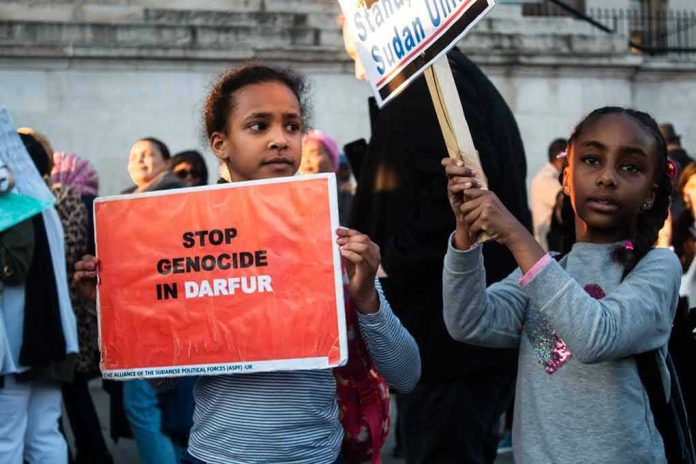
When a city of a quarter million people is cut off and left to starve as the world watches, the old ghosts of Darfur are no longer just history—they are today’s unfinished business.
Story Snapshot
- El Fasher’s fall to the RSF has left 260,000 civilians trapped without food, water, or medical care
- Mass executions, rape, and starvation are reported, echoing the darkest days of the Darfur crisis
- Only a small fraction of residents have escaped, as humanitarian routes remain blocked and disease spreads
- International protection has failed, raising questions about the future of Sudan and regional stability
El Fasher: A City Under Siege and the Return of Old Nightmares
El Fasher, once a lifeline for North Darfur and a symbol of resistance, now stands as a bleak warning to the world. The Rapid Support Forces (RSF), born from the notorious Janjaweed militias, seized control after a 500-day siege that began in early 2024. The city’s collapse in October 2025 is not just another chapter in Sudan’s conflict—it is a full-circle return to the horrors many believed had been buried with the ashes of Darfur’s past atrocities. Over 260,000 civilians now find themselves encircled, cut off from every basic necessity, with only the faint hope of escape to the west.
Those who have managed to flee El Fasher tell stories that are almost too grim to believe. Mass executions, systematic rape, and the weaponization of starvation have become daily realities inside the city’s broken walls. Humanitarian agencies, whose reach once extended across these neighborhoods, now face blocked roads and the constant threat of violence. The United Nations and World Health Organization report that only a few thousand have reached relative safety in Tawila—the main destination for those lucky or desperate enough to break through. For the rest, the risk of disease, especially cholera, grows with every day that food and clean water run out.
The Power Struggle That Ignited a Catastrophe
The seeds of this crisis were sown long before El Fasher’s siege. After the ouster of Sudan’s longstanding dictator Omar al-Bashir in 2019, the Sudanese Armed Forces (SAF) and RSF forged a fragile partnership. That alliance shattered in April 2023, plunging Sudan into nationwide conflict and thrusting Darfur—especially El Fasher—into the vortex of siege warfare. As the RSF tightened its grip, the SAF was pushed out, and civilians were left as pawns and collateral. The city’s strategic value, as both a humanitarian hub and a resistance stronghold, made it an irresistible prize for those seeking to consolidate power in a lawless landscape.
International organizations warned repeatedly that the escalating violence in El Fasher would lead to catastrophe. Yet, as the RSF pressed its assault and the siege dragged on, global attention shifted elsewhere. By the time the city fell, the echoes of past failures in Darfur had grown deafening. The parallels are unmistakable: mass killings, ethnic targeting, and a humanitarian collapse that no border or treaty can contain.
Humanitarian Collapse and the Failure of International Protection
The aftermath in El Fasher is a masterclass in how quickly a society can unravel when the world looks away. The RSF’s military dominance means those trapped inside have no way out, and those outside can do little more than bear witness. The United Nations and World Health Organization have condemned the violence and demanded immediate humanitarian access, but their pleas have so far yielded little. The International Rescue Committee describes the situation as a “hellscape,” with trauma and deprivation at levels unseen since the early 2000s.
With basic services collapsed and disease spreading unchecked, the city’s fate hangs in a precarious balance. Regional neighbors like Chad and South Sudan now brace for waves of desperate refugees, threatening to destabilize already fragile states. Humanitarian agencies, overwhelmed and outmatched, face the impossible task of saving lives without access, security, or international backing. For the civilians of El Fasher, the calculation is grim: stay and risk starvation or violence, or flee into the unknown with nothing but hope to guide them.
The Broader Implications: A Crisis Unfolding Beyond Borders
El Fasher’s fall is more than a local tragedy—it is a warning that the mechanisms meant to prevent mass atrocities are dangerously broken. The failure of international protection has not only condemned a city, but it has also signaled to would-be perpetrators across the globe that impunity is the new normal. The region faces the prospect of further ethnic violence, prolonged displacement, and the erosion of any remaining trust in global institutions. As the world debates, the crisis in El Fasher deepens, threatening to become the latest in a long line of avoidable catastrophes that history will judge harshly.
The questions raised by El Fasher’s agony are not only for Sudan, but for anyone who believes in the promise of “never again.” What will it take to break the cycle of apathy and failure, and who, if anyone, will answer the call before another city, another people, are lost to the darkness?
Sources:
World Health Organization (WHO)
International Rescue Committee (IRC)
United Nations Human Rights Office







